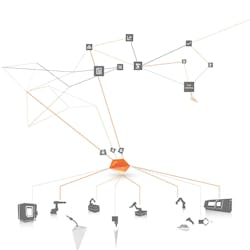Automation is finding its way into more places than ever before. As the reach of automation expands and broadens, the ecosystem of companies developing automation products is becoming more compartmentalized, precise and defined. The companies best poised to take advantage of automation’s expanding influence are those that leverage technologies to create holistic systems.
Automation is a combination of solid hardware and strong, sophisticated software, often augmented with vision and other sensor inputs. As the breadth of automation expands and its influence widens, automation systems have become increasingly intricate and complex under the hood while being simpler to use for operators. As manufacturers look to automate more complicated tasks, automation providers must combine the worlds of hardware and software to create products that are usable by end users with or without a high level of expertise.
Previously, automation was a combination of components—generally hardware with a programmable logic controller (PLC) or robot programming that managed the system. Automation now, however, is made of the same pieces of hardware, but it is managed by powerful advanced software, more and more often incorporating artificial intelligence (AI). As software plays an increasingly dominant role in automation systems, traditional automation suppliers must make a decision that is central to the business model. Do they expand their core competencies to include software development, or do they stay focused on hardware and find the right partners for software?
Ultimately, this issue is not entirely new. There has always been a tension between remaining focused on core competencies versus branching into other disciplines to capitalize on new opportunities and income streams. Should a strong robot company invest resources, research and development for end-of-arm tooling? Should an established controls company make the same investment into mechatronics? And how do conveyors, sensors, safety systems and other peripheral systems and components play into the equation?
In the context of software-driven automation, the question for automation providers becomes: Do we become software developers in addition to building and integrating the hardware? It must be understood that software development moves extremely fast. To keep pace with the small, agile software firms, a conventional automation provider would be required to make large investments and perhaps completely redesign its business model. Incorporating another central competency into a business is not always a wise course and, in some cases, not a viable option. In either scenario, the better choice could be to find the right partner.
Finding that partner, however, is not as simple as selecting the first firm that comes along. There are a number of questions that must be considered, and it’s always best to start at the beginning. First, sound self-analysis is required to determine and define exactly what the company’s existing core technologies are and why a partner is or is not necessary. Failing to define core technologies runs the risk of partnering with an enterprise that does not adequately fill the necessary gap or addresses a need that doesn’t actually exist.
Once existing core technologies are understood and needs are defined, the search can begin for companies that provide targeted products for those needs. As that search is refined, the actual mechanics of the partnership need to be addressed. Do adequate interfaces exist that will allow a potential partner to incorporate its product, or do the interfaces need to be developed? If development is necessary, what features will the new interfaces require?
The elements of interfacing and collaboration also bring to bear the sensitive issue of access to intellectual property (IP). How much of a company’s IP does a partner need to effectively design, implement and incorporate its product? And by implication, where is the line drawn between providing sufficient IP to integrate and protecting valuable business and trade secrets?
In many cases, so much attention is devoted to development that marketing the system is a secondary concern, and that can become a problem if not addressed early in the partnership selection process. What will be the go-to-market strategy? What benefits and attributes will be emphasized? What costs will be shared? Are there cross-promotion opportunities between the partners that make marketing for both firms more cost-efficient? As in most partnership situations, getting these issues addressed early will avoid problems later.
Though that list of considerations may seem significant, keep in mind the lawyers haven’t gotten involved yet. Legal structures and entities, contractual terms, along with research and development agreements are just some of the issues that must be addressed to protect the parties.
Similarly, software companies must strategically think about how they approach the partnership dance. To maximize business potential, they must think about which big players in the automation industry are the best fit, and how do they convince them to open interfaces and equipment for complete integration? What core competencies do they offer that the systems providers need and cannot provide for themselves?
The automation ecosystem is, indeed, changing. Advances in automation technology, software and AI-driven systems make it impractical for one enterprise to be competent in all emerging venues. Those that partner with compatible companies and technologies while leveraging their individual core competencies for holistic systems will thrive.
About the Author

Robert Brodecki
Robert Brodecki is business development manager for food & beverage/consumer goods at KUKA Robotics. Contact him at [email protected].
Sign up for our eNewsletters
Get the latest news and updates

Leaders relevant to this article:
